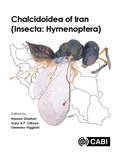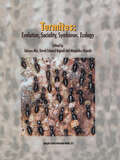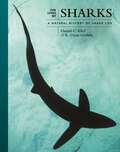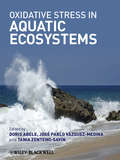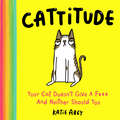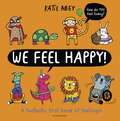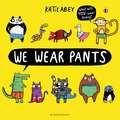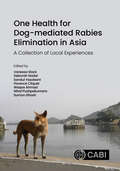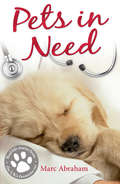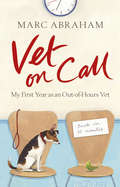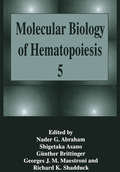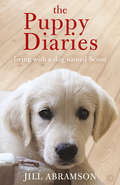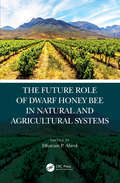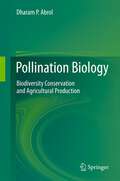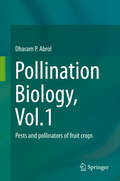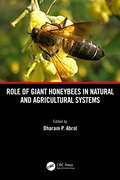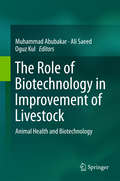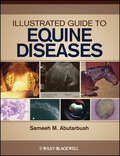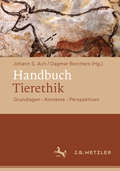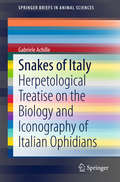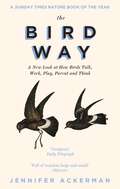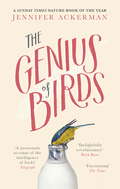- Table View
- List View
Chalcidoidea of Iran (Insecta: Hymenoptera)
by Shaaban Abd-Rabou Dr Christopher Darling Mikdat Doganlar Klarissa Alekseyevna Dzhanokmen Victor Nikolaevich Fursov Emilio Guerrieri M Hayat Jian Huang Petr Janšta Svetlana Nikolaevna Myartseva José Luis Nieves-Aldrey Bernard Pintureau Irinel Eugen Popescu Emilian Pricop Christian Schmid-Egger Javier Torréns Simon Van Noort Vladimir Alexandrovich Trjapitzin Zoya Alexandrovna Yefremova Jeong Yoo Marina Dmitrievna ZerovaThe superfamily Chalcidoidea (Insecta, Hymenoptera) contains in excess of 26,000 described species worldwide, but with an estimated total diversity of more than 500,000 species the vast majority of species have yet to be discovered and described. Most chalcidoid species are parasitoids of hosts in at least 12 different insect orders, attacking the egg, larval or pupal stages, though phytophagy and other life cycles and hosts are known. Iran is the 18th largest country in the world and has a rich and diverse insect fauna, including Chalcidoidea. It is extremely interesting from a biogeographic point of view, and a paradise for an entomologist. This book summarizes the results of all prior research concerning species diversity of Iranian Chalcidoidea, including host records and distribution records by province in Iran as well as world distribution by country for 1,351 species of Chalcidoidea recorded from Iran through the end of 2019. The faunal diversity for each of the 20 families of Chalcidoidea known from Iran is also compared with that known for 15 adjacent countries. In addition, general information on world diversity, recognition, phylogenetic relationships and host relationships are given for each family. As such, the book will be an invaluable source of information for all those involved with chalcidoids, for anyone with an interest in insect systematics, and all those working in crop protection, especially biological control and Integrated Pest Management.
Termites: Evolution, Sociality, Symbioses, Ecology
by Y. Abe David Edward Bignell T. HigashiThe book is a new compendium in which leading termite scientists review the advances of the last 30 years in our understanding of phylogeny, fossil records, relationships with cockroaches, social evolution, nesting, behaviour, mutualisms with archaea, protists, bacteria and fungi, nutrition, energy metabolism,population and community ecology, soil conditioning, greenhouse gas production and pest status.
The Lives of Sharks: A Natural History of Shark Life (The Lives of the Natural World #7)
by Daniel C. Abel Dr. R. Dean GrubbsA richly illustrated and comprehensive introduction to the world’s sharksSharks are the top predators in many marine ecosystems. But tales of the killer instincts and fearsomely sharp senses of these hunters can obscure their full life histories. In fact, sharks are characterful, exhibit surprisingly complex behaviors, and lead secretive lives full of interest in every type of marine habitat. The Lives of Sharks is a fascinating and beautifully illustrated guide to these iconic marine creatures from two world-renowned experts. This book explores shark physiology, anatomy, behavior, ecology, and evolution, as well as conservation and the impact of human activity on shark populations. With stunning photographs and illustrations, as well as profiles of selected species, this is a comprehensive, authoritative, and inviting introduction to global shark life today.
Oxidative Stress in Aquatic Ecosystems
by Doris Abele Jose Pablo Vazquez-Medina Tania Zenteno-SavinReactive oxygen species (ROS) are increasingly appreciated as down-stream effectors of cellular damage and dysfunction under natural and anthropogenic stress scenarios in aquatic systems. This comprehensive volume describes oxidative stress phenomena in different climatic zones and groups of organisms, taking into account specific habitat conditions and how they affect susceptibility to ROS damage. A comprehensive and detailed methods section is included which supplies complete protocols for analyzing ROS production, oxidative damage, and antioxidant systems. Methods are also evaluated with respect to applicability and constraints for different types of research. The authors are all internationally recognized experts in particular fields of oxidative stress research. This comprehensive reference volume is essential for students, researchers, and technicians in the field of ROS research, and also contains information useful for veterinarians, environmental health professionals, and decision makers.
Oxidative Stress in Aquatic Ecosystems
by Doris Abele Pablo Vázquez-Medina Tania Zenteno-SavínReactive oxygen species (ROS) are increasingly appreciated as down-stream effectors of cellular damage and dysfunction under natural and anthropogenic stress scenarios in aquatic systems. This comprehensive volume describes oxidative stress phenomena in different climatic zones and groups of organisms, taking into account specific habitat conditions and how they affect susceptibility to ROS damage. A comprehensive and detailed methods section is included which supplies complete protocols for analyzing ROS production, oxidative damage, and antioxidant systems. Methods are also evaluated with respect to applicability and constraints for different types of research. The authors are all internationally recognized experts in particular fields of oxidative stress research. This comprehensive reference volume is essential for students, researchers, and technicians in the field of ROS research, and also contains information useful for veterinarians, environmental health professionals, and decision makers.
Cattitude: Your Cat Doesn't Give A F*** And Neither Should You
by Katie AbeyA hilarious, colourful collection of straight-talking, no-nonsense advice from very sassy cats
We Feel Happy: A fantastic first book of feelings!
by Katie AbeyA fantastic first book of feelings that introduces little ones to a wide range of emotions. Why are the animals happy? What has made them feel sad? What do YOU feel excited about?We feel happy when reading our favourite book. We feel calm when we have a bath. We feel excited when we go to a party! We Feel Happy is the perfect book for starting a conversation about feelings with children. The animals are experiencing lots of different emotions, from the hippos who are excited to visit their friends to the shark who is grumpy about brushing its teeth.Includes learning hooks such as counting, first words and recognising animals, interactive speech bubbles, prompts and ideas on how to process and understand our emotions and lots of interesting things to spot on every page.______________________________________________________________________Vibrantly illustrated by the talented Katie Abey, illustrator of We Wear Pants, We Eat Bananas and We Catch the Bus and perfect for fans of You Choose and Just Imagine. We Feel Happy includes the feelings: happy, calm, worried, shy, curious, grumpy, sad, scared, sorry, excited and a guide written by early years specialist, Dr Helen Lewis, with lots of useful information for speaking to children about their emotions.
We Wear Pants
by Katie AbeyPandas wearing pants? Surely not! And what about wombats wearing wellies, sloths in socks, or even giraffes wearing scarves? Whatever you do today...don't forget to get dressed! For any parent who has ever struggled to get their kids dressed - this hilarious book is for YOU! Parents and children will be giggling together as they find their favourite animals wearing funny things. We Wear Pants invites children to choose their favourite things across 12 spreads, packed with animals wearing pants, socks, pyjamas, glasses, shoes, shirts, wellies and more. With interactive speech bubbles and hilarious shout outs. Splashing around in puddles, driving buses and even riding on roller coasters - What will you wear today?
One Health for Dog-mediated Rabies Elimination in Asia: A Collection of Local Experiences
by Ronello Abila Fiaz Ahmad Manzoor Ahmad Genki Arikawa Naila Baig-Ansari Suzanne Barber Omesh Kumar Bharti Victoria J. Brookes Eric Brum Karoon Chanachai Ashoka Dangolla Katinka De Balogh Timothy John Dizon Kinzang Dukpa Salome Dürr Anna S. Fahrion M. Aftab Gohar Ma. Ricci Gomez Gyanendra Gongal Mary Joy Gordoncillo Nicole Perreras Grande Silja Griss Mangala Gunatilake Katie Hampson Michael Hathaway Elly Hiby Akitoyo Hotta Satoshi Inoue Md Hamidul Islam Niti B. Jadeja S. Anzal Jaffari Wajiha Javed Ananda Jayasinghe Chandrika Jayasinghe Koji Kanda Chiho Kaneko Suwicha Kasemsuwan Pankaj Kc Rabia M. Khan Yumi Kirino Tipsarp Kittisiam Shintaro Kobayashi Hirofumi Kugita Kansuda Leelahapongsathon M. A. Masud Qamer Mahmood Daria Llenaresas Manalo Mary Elizabeth Miranda Noel Lee Miranda Naoaki Misawa Scott Newman Yooni Oh K.A.D.N. Perera Oswin Perera Wilaiwan Petsophonsakul Yoenten Phuentshok Ruwini M.S. Pimburage Supalak Prabsriphum Beatriz Puzon Quiambao Sreejith Radhakrishnan Onpawee Sagarasaeranee Naseem Salahuddin Luuk Schoonman David Sutherland Shynie Telmo Lesa Thompson Pasang Tshering Muhammad Rafi Ullah Abi Tamim Vanak Ad Vos Charlotte Warembourg Ewaldus Wera Tikiri Wijayathilaka Omala Wimalaratne Vilaiporn Wongphruksasoong Aya Yajima Takahiko Yoshida Kentaro Yoshii Mirava YusonAlthough an effective human rabies vaccine has existed since 1885, rabies continues to kill an estimated 59,000 people every year. Sixty per cent of these human deaths occur in Asia. The number of animals, especially dogs, who die of rabies is uncalculated. To work towards the global target of eliminating dog-mediated human rabies deaths, the rabies community is applying the One Health approach by jointly focusing on humans and dogs. Written by a multidisciplinary group of scholars and rabies control programme specialists, this book is a collection of experiences and observations on the challenges and successes along the path to rabies control and prevention in Asia. The book: -grounds chapters in solid scientific theory, but retains a direct, practice-focused and inspirational approach; -provides numerous examples of lessons learned and experience-based knowledge gained across countries at different levels of rabies elimination; -brings together and highlights the practices of a strong, international rabies network that works according to the One Health concept. Covering perspectives from almost a dozen Asian countries and a wide range of sectors and disciplines, such as healthcare facilities, veterinary services, laboratories, public health institutes, wildlife research centres and academia, this book is an invaluable resource for rabies practitioners and scholars, but also those working in the wider fields of disease control and cross-sectoral One Health.
Pets in Need
by Marc AbrahamMarc Abraham, the UK's favourite vet, introduces a cast of loveable characters in this story of his life as an emergency vet. From the bouncy retriever puppy with a sore tummy to the tiny gerbil pregnant with triplets, every poorly pet is cared for in Marc's busy surgery. Featuring real-life insight into life as a practicing vet, as well as hints and tips on caring for your own pets, this is a perfect book for animal lovers everywhere.Abridged from the adult edition, Vet on Call.
Vet on Call: My First Year as an Out-of-Hours Vet
by Marc AbrahamWhen his father sat him down and told him to 'make something' of himself, young vet Marc Abraham decided to do it the hard way - by setting up an emergency 'out of hours' clinic. If getting used to the long night shifts wasn't bad enough, emergency cases are rarely straightforward. Whether it was dog who swallowed golf balls, or a gerbil in urgent need of a caesarean, every case had the potential for heartbreak. But animals and their owners could also be hilarious, such as the breeder who unwittingly gave his German Shepherd four testicles. . .Over the course of twelve tough months, the clinic began to flourish. Would Marc finally make something of himself after all?Marc Abraham writes guilelessly about his early mistakes, and the terror and joy involved in saving an animal's life. His memoir is a heart-warming, compelling and thoroughly entertaining look at the life of a vet on call.
Molecular Biology of Hematopoiesis 5
by Nader G. Abraham Shigetaka Asano G. Brittinger G. J. M. Maestroni R. K. ShadduckThis volume of Molecular Biology of Hematopoiesis is dedicated to John W. Adam son, M. D. , Tadamitsu Kishimoto, M. D. , Robert C. Gallo, M. D. , Arthur W. Nienhuis, M. D. , and Franco Mandelli, M. D. , for their contributions in developing an overall view of the state-of-the-art knowledge in the field of hematopoiesis. Richard Champlin, among other renowned clinicians, presented updated information on stem cells and T-cell depletion for bone marrow transplant. A clinical update on thrombopoietin was presented by Pamela Hunt of Amgen and by Kenneth Kaushansky. Arthur Nienhuis' and Katherine Turner's contribu tions to our current knowledge and advances in the fields of growth factors and gene transfer were also recognized during the 9th Symposium on Molecular Biology of Hematopoiesis in Genoa. The chapters cover such diverse areas as preclinical and clinical updates on growth factors and positive and negative regulatory molecules. "Advances in Leukemia: Mechanism and Treatment by Interferon" was presented by Professor Sante Tura. Readers will find presentation of exciting advances that have occurred in the area of hematopoiesis. The elucidation of gene structures of key growth factor proteins such as IL-12 and IL-II will lead to new insights and new approaches in understanding the regulation of hematopoiesis, as well as application of new growth factors.
The Puppy Diaries: Living With a Dog Named Scout
by Jill AbramsonOne sparkling summer day, Jill Abramson brought home a nine-week-old golden retriever named Scout. Over the following year, as she and her husband raised their adorable new puppy, Abramson wrote a hugely popular column for The New York Times's website about the joys and challenges of training this rambunctious addition to their family. Dog-lovers from across the country inundated her with emails and letters, and the photos they sent in of their own dogs became the most visited photo album on the Times's site in 2009. Now, Abramson has gone far beyond the material in her column and written a detailed and deeply personal account of Scout's first year. Part memoir, part manual, part investigative report, The Puppy Diaries continues Abramson's intrepid reporting on all things canine. Along the way, she weighs in on such issues as breeders or shelters, adoption or rescue, raw diet or vegan, pack-leader gurus like Cesar Millan or positive-reinforcement advocates like Karen Pryor. What should you expect when a new puppy enters your life? With utterly winning stories and a wealth of practical information, The Puppy Diaries provides an essential road map for navigating the first year of your dog's life.
The Future Role of Dwarf Honey Bees in Natural and Agricultural Systems
by D. P. AbrolThe future role of dwarf honeybees in natural and agricultural systems provides multidisciplinary perspective about the different facets of dwarf honeybees. The role of dwarf honeybee Apis florea assumes utmost importance in the context of pollinator decline throughout the world threatening stability of ecosystems and global food security. Apis florea is a low land species of south Asia extending more to the west than other Asiatic Apis species. It is an important pollinator of crops in hot and dry agricultural plains. The book is first of its kind which deals in details on varied aspects of Apis florea biology, management, conservation strategies for protecting biodiversity and enhancing crop productivity. The book aims to promote a large, diverse, sustainable, and dependable bee pollinator workforce that can meet the challenge for optimizing food production well into the 21st century. Features: Apis florea provides source of livelihood in mountainous areas and marginal farmers. This book will for the first time present the beekeeping from the perspective of agricultural production and biodiversity conservation An excellent source of advanced study material for academics, researchers and students and programme planners Excellent pollinator of tropical and subtropical crops fruits vegetables etc less prone to diseases and enemies Covering the latest information on various aspects of Apis florea biology, this book brings the latest advances together in a single volume for researchers and advanced level students This book will be useful to pollination biologists, honeybee biologists in entomology departments, students, teachers, scientists of agriculture, animal behaviour, botany, conservation, biology, ecology, entomology, environmental biology, forestry, genetics, plant breeding, horticulture, toxicology, zoology, seed growers and seed agencies and shall serve as reference book for students, teachers, researchers, extension functionaries and policy planners.
The Future Role of Dwarf Honey Bees in Natural and Agricultural Systems
by Dharam P. AbrolThe future role of dwarf honeybees in natural and agricultural systems provides multidisciplinary perspective about the different facets of dwarf honeybees. The role of dwarf honeybee Apis florea assumes utmost importance in the context of pollinator decline throughout the world threatening stability of ecosystems and global food security. Apis florea is a low land species of south Asia extending more to the west than other Asiatic Apis species. It is an important pollinator of crops in hot and dry agricultural plains. The book is first of its kind which deals in details on varied aspects of Apis florea biology, management, conservation strategies for protecting biodiversity and enhancing crop productivity. The book aims to promote a large, diverse, sustainable, and dependable bee pollinator workforce that can meet the challenge for optimizing food production well into the 21st century. Features: Apis florea provides source of livelihood in mountainous areas and marginal farmers. This book will for the first time present the beekeeping from the perspective of agricultural production and biodiversity conservation An excellent source of advanced study material for academics, researchers and students and programme planners Excellent pollinator of tropical and subtropical crops fruits vegetables etc less prone to diseases and enemies Covering the latest information on various aspects of Apis florea biology, this book brings the latest advances together in a single volume for researchers and advanced level students This book will be useful to pollination biologists, honeybee biologists in entomology departments, students, teachers, scientists of agriculture, animal behaviour, botany, conservation, biology, ecology, entomology, environmental biology, forestry, genetics, plant breeding, horticulture, toxicology, zoology, seed growers and seed agencies and shall serve as reference book for students, teachers, researchers, extension functionaries and policy planners.
Pollination Biology: Biodiversity Conservation and Agricultural Production
by Dharam P. AbrolThis book has a wider approach not strictly focused on crop production compared to other books that are strictly oriented towards bees, but has a generalist approach to pollination biology. It also highlights relationships between introduced and wild pollinators and consequences of such introductions on communities of wild pollinating insects. The chapters on biochemical basis of plant-pollination interaction, pollination energetics, climate change and pollinators and pollinators as bioindicators of ecosystem functioning provide a base for future insights into pollination biology. The role of honeybees and wild bees on crop pollination, value of bee pollination, planned honeybee pollination, non-bee pollinators, safety of pollinators, pollination in cages, pollination for hybrid seed production, the problem of diseases, genetically modified plants and bees, the role of bees in improving food security and livelihoods, capacity building and awareness for pollinators are also discussed.
Pollination Biology, Vol.1: Pests and pollinators of fruit crops
by Dharam P. AbrolThe book covers interplay between pest management strategies and safety of pollinators. Detailed information is provided on pests and pollinators of temperate, subtropical and tropical fruit crops. Most of the fruit crops are highly cross pollinated and depend upon insects or benefit from insect pollination for fruit set. Insect pests on the other hand cause major economic damage on fruit crops in tropics, subtropics and temperate. Evidently, pest management in fruit crops on one hand and providing safety to the pollinators on the other is a challenging task in the context of increasing horticultural productivity without upsetting the ecological balance. This book aims to integrate and develop pest control strategies in a way to minimize their impact on beneficial insect species such as natural enemies and pollinators to enhance fruit production and quality. The book covers interplay between pest management strategies and safety of pollinators. Detailed information is provided on pests and pollinators of temperate, subtropical and tropical fruit crops. Pollinators play a crucial role in flowering plant reproduction and in the production of most fruits and vegetables. Most of the fruit crops are highly cross pollinated and depend upon insects or benefit from insect pollination for fruit set. Insect pests on the other hand cause major economic damage on fruit crops in tropics, subtropics and temperate. Evidently, pest management in fruit crops on one hand and providing safety to the pollinators on the other is a challenging task in the context of increasing horticultural productivity without upsetting the ecological balance. This book aims to integrate and develop pest control strategies in a way to minimize their impact on beneficial insect species such as natural enemies and pollinators to enhance fruit production and quality. Most of the fruit crops are highly cross pollinated and depend upon insects or benefit from insect pollination for fruit set. Insect pests on the other hand cause major economic damage on fruit crops in tropics, subtropics and temperate. Evidently, pest management in fruit crops on one hand and providing safety to the pollinators on the other is a challenging task in the context of increasing horticultural productivity without upsetting the ecological balance. This book aims to integrate and develop pest control strategies in a way to minimize their impact on beneficial insect species such as natural enemies and pollinators to enhance fruit production and quality. The book covers interplay between pest management strategies and safety of pollinators.
Role of Giant Honeybees in Natural and Agricultural Systems
by Dharam P. AbrolRole of Giant Honeybees in Natural and Agricultural Systems provides multidisciplinary perspective about the different facets of giant honeybees. Giant honeybees–Apis dorsata and Apis laboriosa are excellent pollinators of crops, fruits, and vegetables in cultivated and natural lanscapes. Their large size, long foraging range, and large work force make them the most spectacular of all honeybee species for crop pollination and honey production. Due to their decline, ecosystems and global food security are being threatened. This book is the first of its kind which deals in detail on varied aspects of giant honeybee biology, management, conservation strategies for protecting biodiversity and enhancing crop productivity. It aims to promote a large, diverse, sustainable, and dependable bee pollinator workforce that can meet the challenge for optimizing food production in 21st century. SALIENT FEATURES: Covers the latest information on various aspects of biology of giant honeybees and brings the latest advances together in a single volume for researchers and advanced level students Provides an excellent source of advanced study material for academics, researchers and students and programme planners Provides an excellent source of livelihood in mountainous areas and marginal farmers Deals with biology, management and conservation strategies for protecting biodiversity and enhancing crop productivity. Excellent pollinator of tropical and subtropical crops, fruits, vegetables, etc. less prone to diseases and enemies This book will be useful for pollination biologists, honeybee biologists, scientists working in agriculture, animal behavior, conservation, biology, ecology, entomologists, environmental biologists, etc.
The Role of Biotechnology in Improvement of Livestock: Animal Health and Biotechnology
by Muhammad Abubakar Ali Saeed Oguz KulThis book examines how biotechnology can improve livestock breeding and farming, and thereby also animal products. In the first chapters the reader will discover which techniques and approaches are currently used to improve animal breeding, animal health and the value of animal products. Particular attention is given to reproduction techniques, animal nutrition and livestock vaccines that not only enhance animal health but also have a significant effect on human health by ensuring safe food procurement and preventing zoonotic diseases. In addition, modern biotechnology can increase not only productivity but also the consistency and quality of animal food, fiber and medical products. In the second part of the book, issues such as how animal biotechnology could affect the environment and the important topic of animal waste management are explored. In the concluding chapter, the authors discuss future challenges related to animal biotechnology. This work will appeal to a wide readership, from scientists and professionals working in animal production, to those in farm animal management and veterinary science.
Illustrated Guide to Equine Diseases
by Sameeh M. AbutarbushIllustrated Guide to Equine Diseases covers an extensive range of diseases with over one thousand color figures that provide equine clinicians with a multitude of diagnostic references. It covers diseases of the respiratory, gastrointestinal, nervous, reproductive, ocular, musculoskeletal, urinary, integumentary, endocrine, and cardiovascular systems, and provides readers with a clinical picture of each disease, including a brief synopsis, presenting signs, and diagnostic procedures. It not only examines diseases from a clinical approach, but also includes diagnostic modalities such as radiology, nuclear scintigraphy, CAT scan, cytology, histopathology, and postmortem findings.
Handbuch Tierethik: Grundlagen – Kontexte – Perspektiven
by Johann S. Ach Dagmar BorchersDas Handbuch führt ein in zentrale Begriffe, Konzeptionen, Themen- und Problemfelder der Tierethik. Neben der Geschichte der Tierethik, relevanten Konzepten und Theorien sowie einer Bandbreite unterschiedlicher Anwendungskontexte findet sich auch eine Darstellung der Tierphilosophie und ihrer wichtigsten Fragestellungen. Das Handbuch will darüber hinaus auch die sich in aktuellen Diskussionen und Kontroversen abzeichnenden Perspektiven der Tierethik umfassend vorstellen. Ziel des Handbuchs ist es, das breite Spektrum inhaltlicher und begrifflicher Aspekte der historischen und gegenwärtigen Tierethik zu reflektieren und einen Einblick in den aktuellen Diskussionsstand zu geben.
Snakes of Italy: Herpetological Treatise on the Biology and Iconography of Italian Ophidians (SpringerBriefs in Animal Sciences)
by Gabriele AchilleThis book offers a comprehensive review of the biology of snakes, focusing on Italian species. The snakes of Italy belong to the two families Colubridae and Viperidae, and for each species the systematic classification and chorology including distribution maps are presented. Furthermore, readers will learn how to carry out field studies, how to handle snakes and how to photograph them. The book concludes with a chapter on the iconography of historical Italian snakes and their importance in popular science, and one on myths and legends. This SpringerBriefs volume will appeal to herpetologists and technical staff. The section on iconography may also be of interest to museum staff.
Biologen in der Industrie: Ein virtuelles Praktikum
by Tilman Achstetter Gerd KlöckDer Weg in die Grundlagenforschung steht nur wenigen Absolventen von Biologiestudiengängen offen. Die meisten Biologen orientieren sich daher in der Wirtschaft. Die Autoren zeigen in diesem Buch in Form eines virtuellen Praktikums in der fiktiven Firma „TiGer BioTec" auf, welche Aufgaben Biologen, aber auch andere Naturwissenschaftler in der freien Wirtschaft erwarten können. Das Buch veranschaulicht in einem Planspiel mit Praxisbeispielen und Übungsaufgaben Aspekte der Marktrecherche, Informationsbeschaffung, sowie der Produktentwicklung, und gibt einen Einblick in die Bedeutung von Projektmanagement und Qualitätssicherung. Das Buch wendet sich an Biologen und andere Naturwissenschaftler, die eine Alternative zur Tätigkeit in der Grundlagenforschung suchen. Es ist eine wertvolle Orientierungshilfe für Lehrer wie Schüler von Gymnasien, Fachschulen, und Berufsakademien, welche sich ein praxisnahes Bild vom Beruf des Naturwissenschaftlers machen wollen.
The Bird Way: A New Look at How Birds Talk, Work, Play, Parent, and Think
by Jennifer AckermanFrom the New York Times bestselling author of The Genius of Birds, a radical investigation into the bird way of being, and the recent scientific research that is dramatically shifting our understanding of birds. 'There is the mammal way and there is the bird way.' This is one scientist's pithy distinction between mammal brains and bird brains: two ways to make a highly intelligent mind. But lately, scientists have taken a new look at bird behaviours they've previously dismissed as anomalies. What they're finding is upending the traditional view of how birds live, how they communicate, forage, court, survive. They're also revealing the remarkable intelligence underlying these activities, abilities we once considered uniquely our own - deception, manipulation, kidnapping, infanticide, but also, ingenious communication between species, collaboration, altruism and play. Some of these behaviours are biological conundrums that seem to push the edges of - well - birdness: A mother bird that kills her own infant sons, and another that selflessly tends to the young of other birds. Young birds that devote themselves to feeding their siblings and others so competitive they'll stab their nestmates to death. Birds that give gifts and birds that steal, birds that dance or drum, that paint their creations or paint themselves, and birds that summon playmates with a special call - and may hold the secret to our own penchant for playfulness and the evolution of laughter. Drawing on personal observations, the latest science, and her bird-related travel around the world, Ackerman shows there is clearly no single bird way of being. In every respect, in plumage, form, song, flight, lifestyle, niche, and behaviour, birds vary. It's what we love about them.
The Genius of Birds: The Intelligent Life of Birds
by Jennifer AckermanBirds are astonishingly intelligent creatures. In fact, according to revolutionary new research, some birds rival primates and even humans in their remarkable forms of intelligence. Like humans, many birds have enormous brains relative to their size. Although small, bird brains are packed with neurons that allow them to punch well above their weight.In The Genius of Birds, acclaimed author Jennifer Ackerman explores the newly discovered brilliance of birds and how it came about. As she travels around the world to the most cutting-edge frontiers of research - the distant laboratories of Barbados and New Caledonia, the great tit communities of the United Kingdom and the bowerbird habitats of Australia, the ravaged mid-Atlantic coast after Hurricane Sandy and the warming mountains of central Virginia and the western states - Ackerman not only tells the story of the recently uncovered genius of birds but also delves deeply into the latest findings about the bird brain itself that are revolutionizing our view of what it means to be intelligent.Consider, as Ackerman does, the Clark's nutcracker, a bird that can hide as many as 30,000 seeds over dozens of square miles and remember where it put them several months later; the mockingbirds and thrashers, species that can store 200 to 2,000 different songs in a brain a thousand times smaller than ours; the well-known pigeon, which knows where it's going, even thousands of miles from familiar territory; and the New Caledonian crow, an impressive bird that makes its own tools.But beyond highlighting how birds use their unique genius in technical ways, Ackerman points out the impressive social smarts of birds. They deceive and manipulate. They eavesdrop. They display a strong sense of fairness. They give gifts. They play keep-away and tug-of-war. They tease. They share. They cultivate social networks. They vie for status. They kiss to console one another. They teach their young. They blackmail their parents. They alert one another to danger. They summon witnesses to the death of a peer. They may even grieve.This elegant scientific investigation and travelogue weaves personal anecdotes with fascinating science. Ackerman delivers an extraordinary story that will both give readers a new appreciation for the exceptional talents of birds and let them discover what birds can reveal about our changing world.
